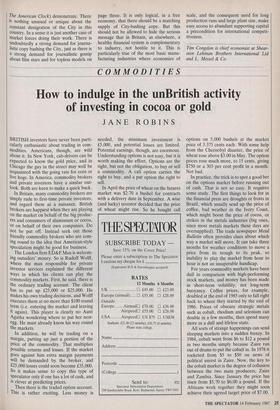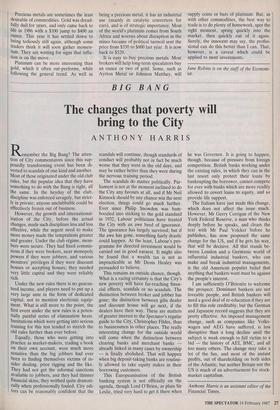COMMODITIES
How to indulge in the unBritish activity of investing in cocoa or gold
JANE ROBINS
BRITISH investors have never been parti- cularly enthusiastic about trading in com- modities. Americans, though, are wild about it. In New York, cab-drivers can be expected to know the gold price, and in Chicago the guy in the street may well be acquainted with the going rate for corn or live hogs. In America, commodity brokers and private investors have a similar out- look. Both are keen to make a quick buck.
In Britain, many commodity brokers are simply rude to first-time private investors, and regard them as a nuisance. British brokers are happiest when they are playing on the market on behalf of the big produc- ers and consumers of aluminium or cocoa, or on behalf of their own companies. Do not be put off. Instead seek out those friendly commodity brokers who are com- ing round to the idea that American-style speculation might be good for business.
The London firm ED&F Man is welcom- ing outsiders' money. So is Rudolf Wolff, where the man responsible for private investor services explained the different ways in which his clients can play the commodity markets. First, he said, there is the ordinary trading account. The client has to put up £25,000 or $25,000. He makes his own trading decisions, and Wolff executes them at no more than $100 round term (i.e. entering the market and leaving it again). This player is clearly no Aunt Agatha wondering where to put her nest- egg. He must already know his way round the markets.
In addition, he will be trading on a margin, putting up just a portion of the price of the commodity. That multiplies Possible returns and losses. If the market goes against him extra margin payments will be demanded by the broker, and £25,000 losses could soon become £35,000. So it makes sense to copy this type of speculator only if one has a lot of cash, and is clever at predicting prices.
Then there is the traded option account. This is rather exciting. Less money is needed, the minimum investment is £5,000, and potential losses are limited. Potential earnings, though, are enormous. Understanding options is not easy, but it is worth making the effort. Options are the right, but not the obligation, to buy or sell a commodity. A call option carries the right to buy, and a put option the right to sell.
In April the price of wheat on the futures market was $2.70 a bushel for contracts with a delivery date in September. A wise (and lucky) investor decided that the price of wheat might rise. So he bought call options on 5,000 bushels at the market price of 3.375 cents each. With some help from the Chernobyl disaster, the price of wheat rose above $3.00 in May. The option prices rose much more, to 15 cents, giving $750 or a 303 per cent profit in a month. Not bad.
In practice, the trick is to spot a good bet on the options market before running out of cash. That is not so easy. It requires some study. The first things to look for in the financial press are droughts or frosts in Brazil, which usually send up the price of coffee, bad weather in the Ivory Coast, which might boost the price of cocoa, or strikes in the metals industries (big ones, since most metals markets these days are oversupplied). The trade newspaper Metal Bulletin often provides clues about which way a market will move. It can take three months for weather conditions to move a price from its trough to its peak, so inability to play the market from hour to hour is not an insuperable handicap.
For years commodity markets have been dull in comparison with high-performing stock markets, and money has been made in short-term volatility, not long-term buoyancy. Coffee prices, for example, doubled at the end of 1985 only to fall right back to where they started by the end of 1986. Prices of obscure strategic metals such as cobalt, rhodium and selenium can double in a few months, then spend many more in a dull and lifeless state.
All sorts of strange happenings can send sleeping markets into a sudden frenzy. In 1984, cobalt went from $6 to $12 a pound in two months simply because Zaire ran out of drums to put the cobalt in. In 1978 it rocketed from $5 to $50 on news of political unrest in Zaire. Now, the key to the cobalt market is the degree of collusion between the two main producers, Zaire and Zambia. Since January the price has risen from $5.70 to $6.00 a pound. If the Africans work together they might soon achieve their agreed target price of $7.00. Precious metals are sometimes the least desirable of commodities. Gold was dread- fully dull for years, and only came back to life in 1986 with a $100 jump to $400 an ounce. This year it has settled down to being tediously still again, although some traders think it will soon gather momen- tum. They are waiting for signs that infla- tion is on the move.
Platinum can be more interesting than gold, which it often out-performs, while following the general trend. As well as being a precious metal, it has an industrial use (mainly in catalytic converters for cars), and is of strategic importance. Most of the world's platinum comes from South Africa and worries about disruption in the mines because of political turmoil sent the price from $350 to $600 last year. It is now back to $520.
It is easy to buy precious metals. Most brokers will help long-term speculators buy an ounce or two of gold. Some, such as Ayrton Metal or Johnson Matthey, will supply coins or bars of platinum. But, as with other commodities, the best way to trade is to do plenty of homework, spot the right moment, spring quickly into the market, then quickly out of it again. Surely, the innocent may say, the profes- sional can do this better than I can. That, however, is a caveat which could be applied to most investments.
Jane Robins is on the staff of the Econom- ist.



























































 Previous page
Previous page